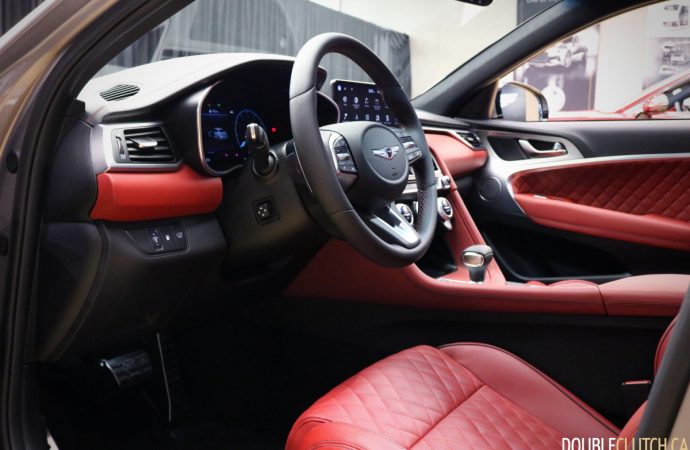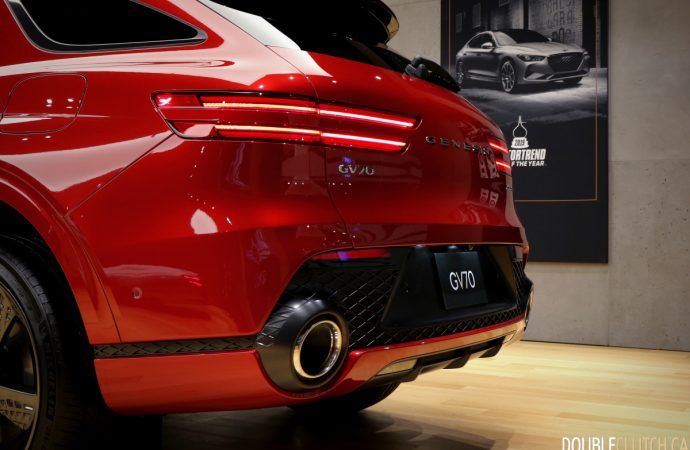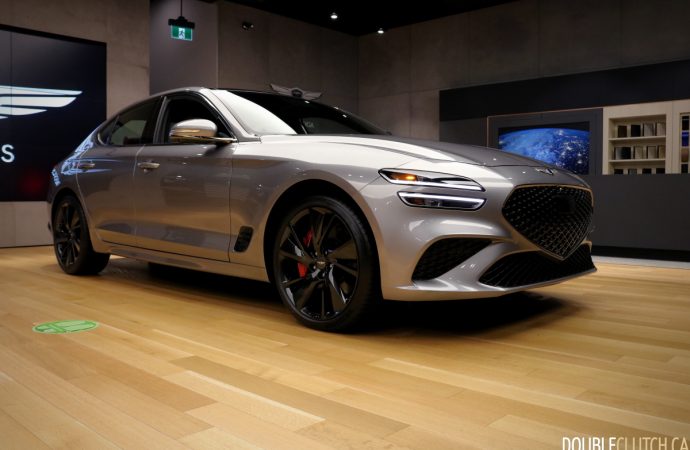The Genesis G70 has already been making waves for several years now, but given how car buyers today are shying away from sedans in favour of crossovers, it can’t conquer the compact luxury car market alone. To do that, Genesis has engineered a crossover counterpart and given its smallest sedan a fairly radical facelift. We took a first look at the all-new 2022 Genesis GV70 and revised 2022 Genesis G70 and came away impressed.
Genesis hasn’t been shy about putting the Porsche Macan in the GV70’s crosshairs, and that’s particularly evident in the exterior design. The rear quarter windows evoke shades of Porsche 928, while the whole look is one much sleeker than what many competitors offer. There’s no rugged posturing by way of such cliche crossover styling elements as unpainted plastic wheel arch trim or excessively aggressive approach and departure angles. Genesis signatures like the horizontally-split lamps, shield-shaped grille and downswept side character lines are all on display, although the design has been spiced up with broad haunches that emphasize the GV70’s rear-wheel-drive architecture and give the illusion of a sharply-raked tumblehome.
Genesis offers the GV70 with two distinct exterior appearances depending on engine. While 2.5T models feature minimized bumper vents and slim, contoured faux exhaust tips, 3.5T models fire up the afterburners with massive jet-age faux exhaust tips, extensive cross-hatching in the rear valence and larger, more aggressive front bumper vents. While exhaust trim the size of drainage pipes sounds garish at first, it works surprisingly well and certainly fits with the GV70’s mission to provide a sporting experience to compact crossover buyers.
On the inside of the GV70, Genesis is once again changing how drivers interact with the infotainment system. Instead of a tea plate-sized iPod-style scroll wheel like in the G80 and GV80 or an exclusively touchscreen system like in the G70, the GV70 has a multifunction knob in the centre console, something that’s sure to be familiar to many luxury car drivers. We found it to be placed very well from an ergonomic standpoint and work intuitively in the preproduction model we viewed. As for audio, 2.5T Advanced trims and up get a 15-speaker Lexicon surround sound system that looks quite promising for audiophiles.
As for overall interior design, the GV70 keeps things classy with a minimalist look. Hard keys for the infotainment are within easy reach and the climate controls feature a classic two-dial design, but most secondary controls have been moved down onto the console. This paves the way for plenty of lovely stitched dashboard surfaces and a pair of very usable cupholders, along with a covered phone compartment with wireless charging and USB inputs.
Given how all Genesis vehicles in Canada are to-order, Genesis offers some absolutely wild colour combinations. How about burgundy leather that’s closer to magenta in tone? A green interior with tan seat belts? Four different matte paint options? Absolutely. Sure, greyscale colours are still on the options list, but with such broad colourways on tap, why order a car that blends in?
2.5-litre turbocharged four-cylinder engine making 300 horsepower and 311 lb.-ft. of torque. In case that isn’t enough, Sport trims get a 3.5-litre turbocharged V6 cranking out a proper 375 horsepower and 391 lb.-ft. of torque. All Canadian GV70s route power to all four wheels, although the top-tier 3.5T Sport Plus trim adds a little extra spice by way of an electronically-variable mechanical limited-slip rear differential. Curiously, starting the GV70 can be done using a fingerprint scanner, a neat implementation of biometrics that lets each driver immediately access their profile for seat, mirror, steering column position, infotainment and general vehicle settings.
As for the G70 sport sedan, it receives a major facelift for 2022. Up front, the shield grille and split headlamps cut a rakish look, while toned-down side vents let the G70’s character lines do the talking. Around back, the split lamp treatment has been applied to the tail lamps as the reversing lamps and license plate have been relocated down onto the lower valence. The rear bumper has also been subtly re-shaped while the trunk lid is all-new and features the Genesis name in all-caps instead of the winged Genesis logo. Overall, it’s a dramatic revision that really gives the G70 a clear identity as a Genesis.
On the inside of the G70, changes have been much more subtle. The infotainment screen is larger with a subtly revamped user interface and the cluster is now digital. Genesis has also gone heavier on the leather and stitched surfaces while bringing in new colour options such as bright red Nappa leather. Available engines are still a two-litre turbocharged four-cylinder and a 3.3-litre turbocharged V6, although 3.3T Sport and 3.3T Dynamic trims gain a variable muffler that adds an extra three horsepower. Dearly departed is the three-pedal 2.0T Sport trim, a low-volume model that earned the hearts of enthusiasts and the motoring press. While it stood alone as the last manual entry-level sports sedan in North America, it only made up around five per cent of G70 sales, so it didn’t make much sense to keep around. In its place is a little something Genesis calls drift mode. It essentially routes all power to the rear wheels for a more playful feel.
Expect pricing for the 2022 Genesis GV70 to be unveiled closer to its on-sale date this summer, although pre-orders are now open for those who really want one. As for the updated G70, pricing will be announced closer to its on-sale date later this year, although expect it to not wander too far from current G70 pricing.






